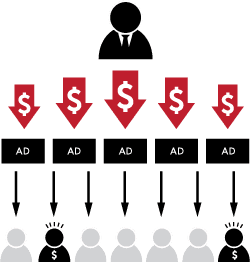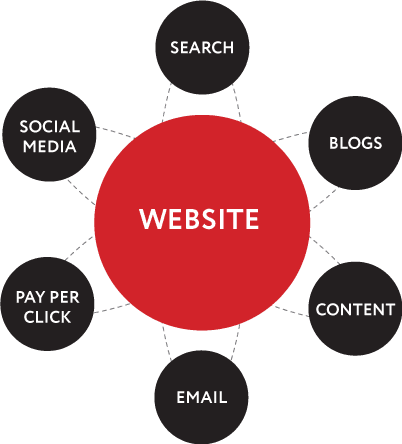There’s a new kid in town, and it’s name is Inbound Marketing. If you’ve never heard the term, you definitely need to read this article. I’ll give you a quick introduction to what Inbound Marketing is, how it works, and why it’s the hottest way to get new leads and sales. But before we get into the new stuff, let’s see how it compares to the kind of marketing we know now…
The Old Paradigm: Outbound Marketing
 Outbound Marketing is traditional advertising as we know it. It’s called “outbound” because it’s based around pushing a message out with the hope that your ideal customer happens to be listening.
Outbound Marketing is traditional advertising as we know it. It’s called “outbound” because it’s based around pushing a message out with the hope that your ideal customer happens to be listening.
Outbound Marketing uses methods like:
- Radio
- Television
- Cold Calling
- Direct Mail
- Tradeshows
Problems with Outbound Marketing
- It’s easy to block. Look at Caller ID, TiVo, Satellite Radio, and any admin assistant’s trash bin.
- It’s horribly inefficient. It costs a lot of money and the vast majority of ads land on deaf ears.
- It’s difficult to measure. How much business did your last radio or newspaper campaign generate?
From Push to Pull: The Inbound Marketing Revolution

Inbound Marketing changes the direction of advertising from push to pull. It places emphasis on being found by your ideal customer, instead of wasting money chasing after customers who aren’t interested. It’s a targeted and strategic approach that turns your company into a customer magnet.
How does Inbound Marketing work?
Inbound Marketing combines several smaller areas of online marketing into a single co-ordinated marketing system:

Inbound Marketing makes your website the central hub of your marketing activities.
Customers are driven to the website using a variety of methods:
- Blogs
- Social media
- Content (articles, whitepapers, case studies, e-books, videos, etc)
- Search engines
- Email campaigns
- Pay-per-click (e.g. Google AdWords, Facebook Ads, LinkedIn Ads)
- And yes, even Outbound Marketing channels too.
Your website is set up to:
- Capture leads
- Cultivate the relationship
- Convert leads into customers
In some cases, such as an optimized e-commerce page, all of this happens in a single step. In longer sales cycles (e.g. bigger ticket items), it may happen over the course of several visits to the website, conversations, emails, etc.
Key Concepts of Inbound Marketing
- Focuses on being found by customers who need your products and services.
- Embraces a quality-over-quantity approach to advertising.
- Focuses on improving both the top and middle of your sales funnel.
Benefits of Inbound Marketing
1. Lower Cost Per Lead
 HubSpot did a study over the past 3 years comparing dollars spent on advertising vs. the number of leads generated for nearly 1,000 marketing professionals. They found that businesses using traditional “outbound” media spent on average $346 per lead (that’s radio, cold calling, tradeshows, etc.) In comparison, businesses who primarily used Inbound Marketing, spent only $135. That’s over 60% lower cost per lead!
HubSpot did a study over the past 3 years comparing dollars spent on advertising vs. the number of leads generated for nearly 1,000 marketing professionals. They found that businesses using traditional “outbound” media spent on average $346 per lead (that’s radio, cold calling, tradeshows, etc.) In comparison, businesses who primarily used Inbound Marketing, spent only $135. That’s over 60% lower cost per lead!
2. Top-of-Mind Awareness
Many businesses want to be first in their customer’s minds, but have no great way of doing it… at least without spending a fortune on advertising. Inbound Marketing not only allows you to achieve top of mind awareness, but build lasting value with prospective customers—at a fraction of the cost.
3. Reduced Cost of Sale Through Customer Education
Educating customers is another key challenge many businesses face with their marketing. Your blog (part of a great Inbound Marketing mix) is a great way to educate customers about your products, services, and company. It can not only educate them about the lesser-known things you do, but shorten your sales cycle by answering many of the questions they might ask during the sales process.
4. Warm Up Leads and Build Relationships
Through providing valuable content, educating customers, and letting them get to know you better, your leads start warming up to you. You’re essentially building relationships with prospects before they become customers. And once you do finally speak with them, there’ll be much less ice to break and a lot more trust in the air. That always makes for a better sale.
5. Get Valuable Marketing Data
Because of its online nature, Inbound Marketing allows you to gather a boatload of useful data about your customers and their actions. This data can be used to make smart marketing decisions that improve your response rates, sales and overall profitability. No other medium can provide this much, or this accurate, data about your marketing.
Go Inbound!
If you haven’t explored Inbound Marketing for your business yet, you should. Every trend is pointing towards Inbound Marketing being the leading way to get customers, especially in the Business-to-Business (B2B) sector. Make sure you don’t get left behind!










